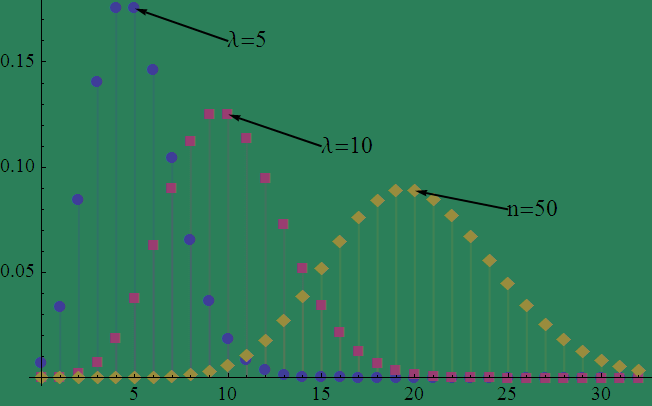博文
The Poisson Probability Distribution(泊松分布)
||
Suppose that we want to find the probability distribution of the number of automobile accidents at a particular intersection during a time period of one week.Think of the time period as being split up into $n$ subintervals, each of which is so small that at most one accident could occur in it with probability different from zero. Denoting the probability of an accident in any subinterval by $p$, we have, for all practical purposes,
P(no accidents occur in a subinterval) = 1 − p,
P(one accident occurs in a subinterval) = p,
P(more than one accident occurs in a subinterval) = 0.
P(one accident occurs in a subinterval) = p,
P(more than one accident occurs in a subinterval) = 0.
Then the total number of accidents in the week is just the total number of subintervals that contain one accident. If the occurrence of accidents can be regarded as independent from interval to interval, the total number of accidents has a binomial distribution.
Although there is no unique way to choose the subintervals, and we therefore know neither $n$ nor $p$, it seems reasonable that as we divide the week into a greater number $n$ of subintervals, the probability $p$ of one accident in one of these shorter subintervals will decrease. Letting $λ = np$ and taking the limit of the binomial probability$p(y) = left( {begin{array}{*{20}{c}} n\ y end{array}} right){p^y}{left( {1 - p} right)^{n - y}}$ as $n to infty $, we have$$begin{array}{l} p(y) = mathop {lim }limits_{n to infty } left( {begin{array}{*{20}{c}} n\ y end{array}} right){p^y}{left( {1 - p} right)^{n - y}}\ ;;;;;;;; = mathop {lim }limits_{n to infty } frac{{n!}}{{y!left( {n - y} right)!}}{left( {frac{lambda }{n}} right)^n}{left( {1 - frac{lambda }{n}} right)^{n - y}}\ ;;;;;;;; = mathop {lim }limits_{n to infty } frac{{{lambda ^y}}}{{y!}}{left( {1 - frac{lambda }{n}} right)^n}frac{{n!}}{{left( {n - y} right)!{n^y}}}{left( {1 - frac{lambda }{n}} right)^{ - y}}\ ;;;;;;;; = frac{{{lambda ^y}}}{{y!}}{e^{ - lambda }} end{array}.$$
Although there is no unique way to choose the subintervals, and we therefore know neither $n$ nor $p$, it seems reasonable that as we divide the week into a greater number $n$ of subintervals, the probability $p$ of one accident in one of these shorter subintervals will decrease. Letting $λ = np$ and taking the limit of the binomial probability$p(y) = left( {begin{array}{*{20}{c}} n\ y end{array}} right){p^y}{left( {1 - p} right)^{n - y}}$ as $n to infty $, we have$$begin{array}{l} p(y) = mathop {lim }limits_{n to infty } left( {begin{array}{*{20}{c}} n\ y end{array}} right){p^y}{left( {1 - p} right)^{n - y}}\ ;;;;;;;; = mathop {lim }limits_{n to infty } frac{{n!}}{{y!left( {n - y} right)!}}{left( {frac{lambda }{n}} right)^n}{left( {1 - frac{lambda }{n}} right)^{n - y}}\ ;;;;;;;; = mathop {lim }limits_{n to infty } frac{{{lambda ^y}}}{{y!}}{left( {1 - frac{lambda }{n}} right)^n}frac{{n!}}{{left( {n - y} right)!{n^y}}}{left( {1 - frac{lambda }{n}} right)^{ - y}}\ ;;;;;;;; = frac{{{lambda ^y}}}{{y!}}{e^{ - lambda }} end{array}.$$
The Poisson probability distribution often provides a good model for the probability distribution of the number Y of rare events that occur in space, time, volume, or any other dimension, where λ is the average value of Y .Such as the probability distribution of the number Y of automobile accidents, industrial accidents, or other types of accidents in a given unit of time.Other examples of random variables with approximate Poisson distributions are the number of telephone calls handled by a switchboard in a time interval, the number of radioactive particles that decay in a particular time period, the number of errors a typist makes in typing a page, and the number of automobiles using a freeway access ramp in a ten-minute interval.
Definition:
A random variable Y is said to have a Poisson probability distribution if and only if
$$p(y) = \frac{{{\lambda ^y}}}{{y!}}{e^{ - \lambda }},\;\;\;y = 0,\;1,\;2,\;...\;,\;\lambda > 0.$$
Relative Mathematica Function
PoissonDistribution[λ] represents a Poisson distribution with mean λ .

https://blog.sciencenet.cn/blog-531885-598560.html
上一篇:Mathematica中的With,Module及Block的用法及区别